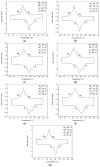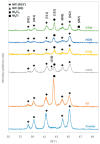Effect of Heat Treatment on Repetitively Scanned SLM NiTi Shape Memory Alloy
- PMID: 30587793
- PMCID: PMC6337191
- DOI: 10.3390/ma12010077
Effect of Heat Treatment on Repetitively Scanned SLM NiTi Shape Memory Alloy
Abstract
Selective Laser Melting (SLM) has been implemented to address the difficulties in manufacturing complex nickel titanium (NiTi) structures. However, the SLM production of NiTi is much more challenging than the fabrication of conventional metals. Other than the need to have a high density that leads to excellent mechanical properties, strict chemical compositional control is required as well for the SLM NiTi parts to exhibit desirable phase transformation characteristics. In addition, acquiring a high transformation strain from the produced specimens is another challenging task. In the prior research, a new approach-repetitive scanning-was implemented to achieve these objectives. The repetitively scanned samples demonstrated an average of 4.61% transformation strain when subjected to the tensile test. Nevertheless, there is still room for improvement as the conventionally-produced NiTi can exhibit a transformation strain of about 6%. Hence, post-process heat treatment was introduced to improve the shape memory properties of the samples. The results showed an improvement when the samples were heat treated at a temperature of 400 °C for a period of 5 min. The enhancement in the shape memory behavior of the repetitively scanned samples was mainly attributed to the formation of fine Ni₄Ti₃ metastable precipitates.
Keywords: 3D printing; 4D printing; NiTi; Selective Laser Melting; additive manufacturing; shape memory alloy.
Conflict of interest statement
The authors declare no conflict of interest.
Figures







Similar articles
-
A Review of Selective Laser Melted NiTi Shape Memory Alloy.Materials (Basel). 2018 Mar 29;11(4):519. doi: 10.3390/ma11040519. Materials (Basel). 2018. PMID: 29596320 Free PMC article. Review.
-
Microstructure and Mechanical Properties of NiTi-Based Eutectic Shape Memory Alloy Produced via Selective Laser Melting In-Situ Alloying by Nb.Materials (Basel). 2021 May 20;14(10):2696. doi: 10.3390/ma14102696. Materials (Basel). 2021. PMID: 34065582 Free PMC article.
-
A Short Review on the Microstructure, Transformation Behavior and Functional Properties of NiTi Shape Memory Alloys Fabricated by Selective Laser Melting.Materials (Basel). 2018 Sep 11;11(9):1683. doi: 10.3390/ma11091683. Materials (Basel). 2018. PMID: 30208641 Free PMC article. Review.
-
Mechanical and shape memory properties of porous Ni50.1Ti49.9 alloys manufactured by selective laser melting.J Mech Behav Biomed Mater. 2017 Apr;68:224-231. doi: 10.1016/j.jmbbm.2017.01.047. Epub 2017 Jan 31. J Mech Behav Biomed Mater. 2017. PMID: 28189977
-
The biocompatibility of dense and porous Nickel-Titanium produced by selective laser melting.Mater Sci Eng C Mater Biol Appl. 2013 Jan 1;33(1):419-26. doi: 10.1016/j.msec.2012.09.008. Epub 2012 Sep 23. Mater Sci Eng C Mater Biol Appl. 2013. PMID: 25428090
Cited by
-
A Review on Additive Manufacturing Methods for NiTi Shape Memory Alloy Production.Materials (Basel). 2024 Mar 8;17(6):1248. doi: 10.3390/ma17061248. Materials (Basel). 2024. PMID: 38541402 Free PMC article. Review.
-
Post-Processing Treatment Impact on Mechanical Properties of SLM Deposited Ti-6Al-4 V Porous Structure for Biomedical Application.Materials (Basel). 2020 Nov 16;13(22):5167. doi: 10.3390/ma13225167. Materials (Basel). 2020. PMID: 33207787 Free PMC article.
-
Wire Arc Additive Manufacturing of NiTi 4D Structures: Influence of Interlayer Delay.3D Print Addit Manuf. 2024 Feb 1;11(1):152-162. doi: 10.1089/3dp.2021.0296. Epub 2024 Feb 15. 3D Print Addit Manuf. 2024. PMID: 38389695 Free PMC article.
-
Influence of Heat Treatment on Microstructure and Properties of NiTi46 Alloy Consolidated by Spark Plasma Sintering.Materials (Basel). 2019 Dec 6;12(24):4075. doi: 10.3390/ma12244075. Materials (Basel). 2019. PMID: 31817662 Free PMC article.
-
4D Printing: The Development of Responsive Materials Using 3D-Printing Technology.Pharmaceutics. 2023 Dec 7;15(12):2743. doi: 10.3390/pharmaceutics15122743. Pharmaceutics. 2023. PMID: 38140084 Free PMC article. Review.
References
-
- Meier H., Haberland C., Frenzel J. Structural and functional properties of NiTi shape memory alloys produced by Selective Laser Melting; Proceedings of the 5th International Conference on Advanced Research in Virtual and Rapid Prototyping; Leiria, Portugal. 28 September–1 October 2011; pp. 291–296.
-
- Elahinia M.H., Hashemi M., Tabesh M., Bhaduri S.B. Manufacturing and processing of NiTi implants: A review. Prog. Mater. Sci. 2012;57:911–946. doi: 10.1016/j.pmatsci.2011.11.001. - DOI
-
- Dadbakhsh S., Speirs M., Kruth J.-P., Schrooten J., Luyten J., Van Humbeeck J. Effect of SLM parameters on transformation temperatures of shape memory nickel titanium parts. Adv. Eng. Mater. 2014;16:1140–1146. doi: 10.1002/adem.201300558. - DOI
-
- Kumar P.K., Lagoudas D.C. Introduction to shape memory alloys. In: Lagoudas D.C., editor. Shape Memory Alloys: Modeling and Engineering Applications. Springer Science; Berlin, Germany: 2008. pp. 1–51.
-
- Humbeeck J.V. Shape memory alloys. In: Schwartz M., editor. Smart Materials. CRC Press; Boca Raton, FL, USA: 2009.
Grants and funding
LinkOut - more resources
Full Text Sources

